目视管理教程
- 格式:ppt
- 大小:175.50 KB
- 文档页数:13

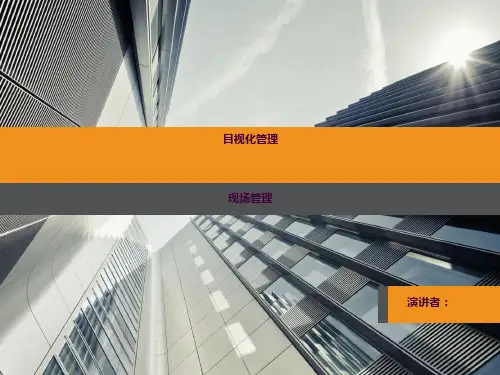

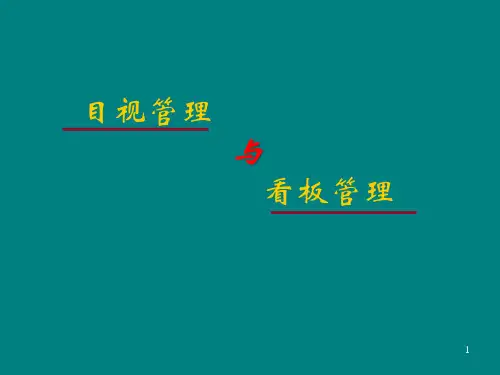
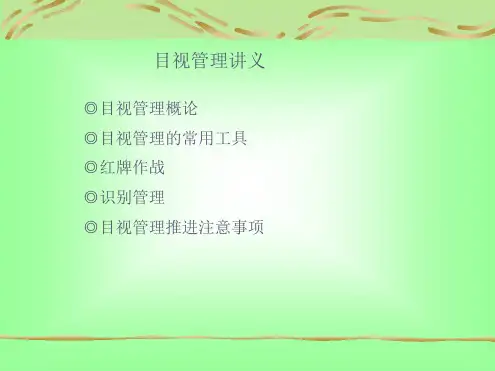
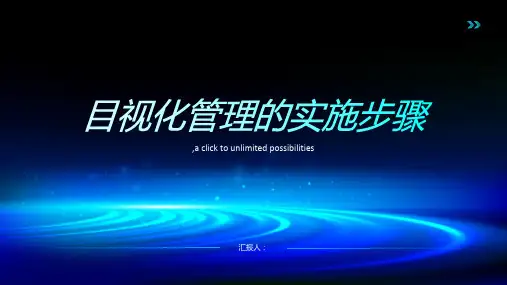

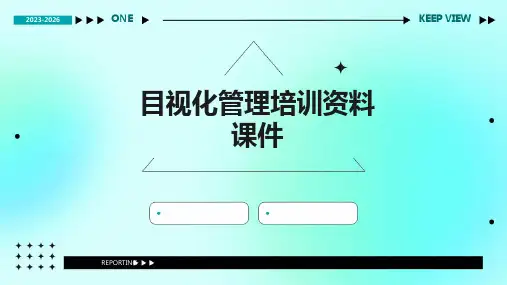
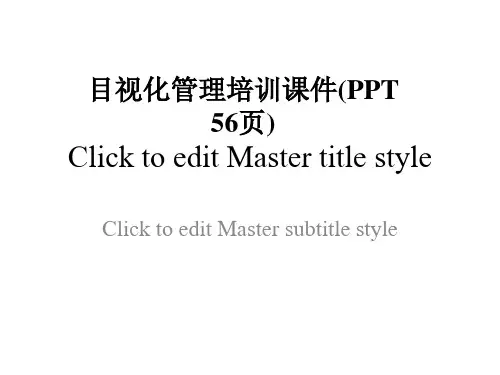
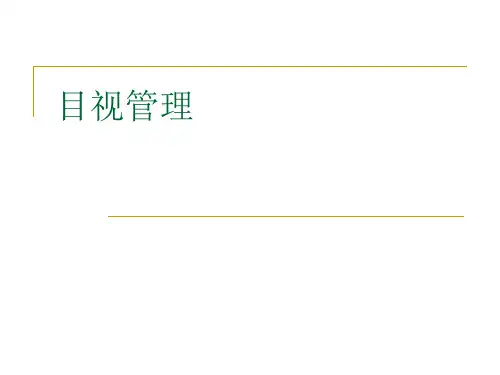
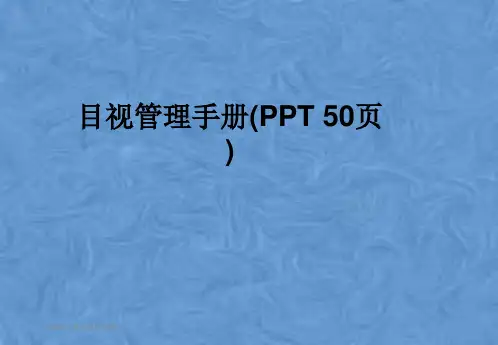
企业5S目视化管理标准操作手册企业5S管理目视化管理操作手册编制:日期:目录第一章目视化管理基础知识导引 (1)1.1目视化管理概述 (1)1.2目视化管理对象 (1)1.3目视化管理的作用 (2)1.4现场目视化管理推进的五个步骤 (2)1.5本手册使用说明 (2)第二章公司级目视化标准 (3)2.1非生产类 (3)2.1.1颜色、线条标准 (3)2.1.1.1常用线条颜色宽度规格(油漆或胶带) (3)2.1.2公司级统一模板 (4)2.1.2.1厂区铭牌 (4)2.1.2.2区域铭牌 (5)2.1.2.3部门门牌 (6)2.1.2.4车间各区域牌........................... 错误!未定义书签。
2.1.2.5车间内各室标牌......................... 错误!未定义书签。
2.1.2.6任务单................................. 错误!未定义书签。
2.1.3公司文化理念宣传看板....................... 错误!未定义书签。
2.1.4公司宣传看板 (7)2.1.4.1公司介绍看板........................... 错误!未定义书签。
2.1.4.2“消防安全”宣传海报................... 错误!未定义书签。
2.1.4.3生产安全报/工人日报 (8)2.1.5展示类标识 (9)2.1.5.1荣誉展示区 (9)2.2生产类 (10)2.2.1生产类看板................................. 错误!未定义书签。
2.2.1.1公司平面布局图 (10)2.2.2厂区公用设施类标识标准 (12)2.2.2.1洗手间标识 (12)第三章厂/部级目视化标准 (14)3.1生产类 (14)3.1.2物流 (14)3.1.2.1工厂平面布局图 (14)3.1.2.2物料指示牌 (15)第四章区域级/科室级目视化标准 (16)4.1非生产类 (16)4.1.1安全看板 (16)4.1.2来访者安全须知 (17)4.2生产类 (18)4.2.1设备 (18)4.2.1.1设备标识 (18)4.2.1.2固定资产标识 (19)4.2.1.3管道流向指示方法 (20)4.2.2质量 (21)4.2.2.1封样件料架 (21)第五章工位级目视化标准 (22)5.1生产类 (22)5.1.1设备 (22)5.1.1.1电器箱标识 (23)5.1.2制造 (24)5.1.2.1防错 (24)第一章目视化管理基础知识导引1.1目视化管理概述目视管理是指通过视觉采集信息后,利用大脑对其进行简单判断而直接产生“对”或“错”的结论的管理方法。
目视化管理的五步骤英文回答:Visual management is a powerful tool for improving productivity and efficiency in the workplace. It involves using visual aids such as charts, graphs, and signs to communicate information and make it easier for employees to understand and follow processes. The five steps of visual management are as follows:1. Identify the purpose: The first step is to clearly define the purpose of the visual management system. This could be to improve communication, increase safety, or enhance productivity. By identifying the purpose, you can determine what information needs to be displayed and how it should be presented.For example, let's say the purpose is to improve communication on the production floor. In this case, visual aids such as status boards, color-coded charts, and visualwork instructions can be used to convey important information to the employees.2. Determine the content: Once the purpose is established, the next step is to determine what content needs to be displayed. This could include production targets, safety guidelines, quality standards, or any other relevant information.For instance, if the purpose is to increase safety, visual aids such as safety signs, hazard maps, and emergency procedures can be displayed in prominentlocations to remind employees of the safety protocols.3. Choose the right visual tools: The third step is to select the appropriate visual tools to convey the information effectively. This could include whiteboards, digital displays, posters, or any other visual aids that are suitable for the purpose and content.For example, if the purpose is to improve productivity, a digital display showing real-time production data can beinstalled on the shop floor. This visual tool can help employees track their progress and identify areas for improvement.4. Design and implement the visual system: Once thetools are chosen, the next step is to design and implement the visual system. This involves creating visuallyappealing displays, organizing the information in a logical manner, and ensuring that it is easily accessible to the employees.For instance, if the purpose is to enhance productivity, a visual system could include a production tracking board that displays the current production status, targets, and any bottlenecks. This board should be placed in a central location where all employees can easily see and understand the information.5. Regularly review and improve: The final step is to regularly review the visual management system and make improvements as necessary. This could involve gathering feedback from employees, monitoring the effectiveness ofthe visual tools, and making adjustments to ensure that the system continues to meet its purpose.For example, if the purpose is to improve communication, regular meetings can be held to discuss the effectivenessof the visual aids and gather suggestions for improvement. This feedback can then be used to make necessary changes to the visual system.中文回答:目视化管理是提高工作场所生产力和效率的强大工具。
1目视化管理是什么?目视化管理是利用形象直观而又色彩适宜的各种视觉感知信息来组织现场生产活动,达到提高劳动生产率的一种管理手段,也是一种利用视觉来进行管理的科学方法。
所以目视化管理是一种以公开化和视觉显示为特征的管理方式。
综合运用管理学、生理学、心理学、社会学等多学科的研究成果。
2目视化管理的特点以视觉信号显示为基本手段,大家都能够看得见。
要以公开化,透明化的基本原则,尽可能的将管理者的要求和意图让大家看得见,借以推动自主管理或叫自主控制。
现场的作业人员可以通过目视的方式将自己的建议、成果、感想展示出来,与领导、同事以及工友们进行相互交流。
所以说目视化管理是一种以公开化和视觉显示为特征的管理方式,也可称为看得见的管理,或一目了然的管理。
这种管理的方式可以贯穿于各种管理的领域当中。
3目视管理的水准目视管理可以分为3个水准:初级水准:有表示,能明白现在的状态中级水准:谁都能判断良否高级水准:管理方法(异常处理等)都列明4目视管理三要点1、无论是谁都能判明是好是坏(异常)2、能迅速判断,精度高3、断结果不会因人而异5目视管理的目的目视管理的目的:以视觉信号为基本手段,以公开化为基本原则,尽可能地将管理者的要求和意图让大家都看得见,借以推动看得见的管理、自主管理、自我控制。
6目视管理的内容1、规章制度与工作标准公开化2、生产任务与完成情况图表化3、与定置管理相结合,实现视角显示信息标准化4、生产作业控制手段现象直观与使用方便化5、物品码放和运送数量标准化6、现场人员着装标准化7、色彩的标准化管理7目视管理的对象(在工厂)工厂里的全部构成要素都是目视管理的对象:如制造过程、物料、设备夹具、文件、场所、人、心情等。
生产现场的目视管理:产品、品质、成本、交期、安全、士气、作业管理、排成交期管理、质量管理、模治具管理等。
间接部门的目视管理:为支持生产也应导入目视管理,如文件管理、行动管理、业务管理、办公设备管理等。